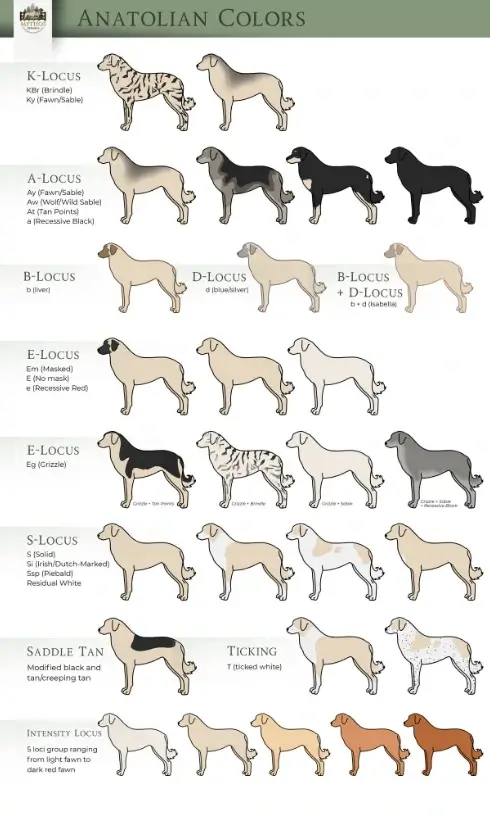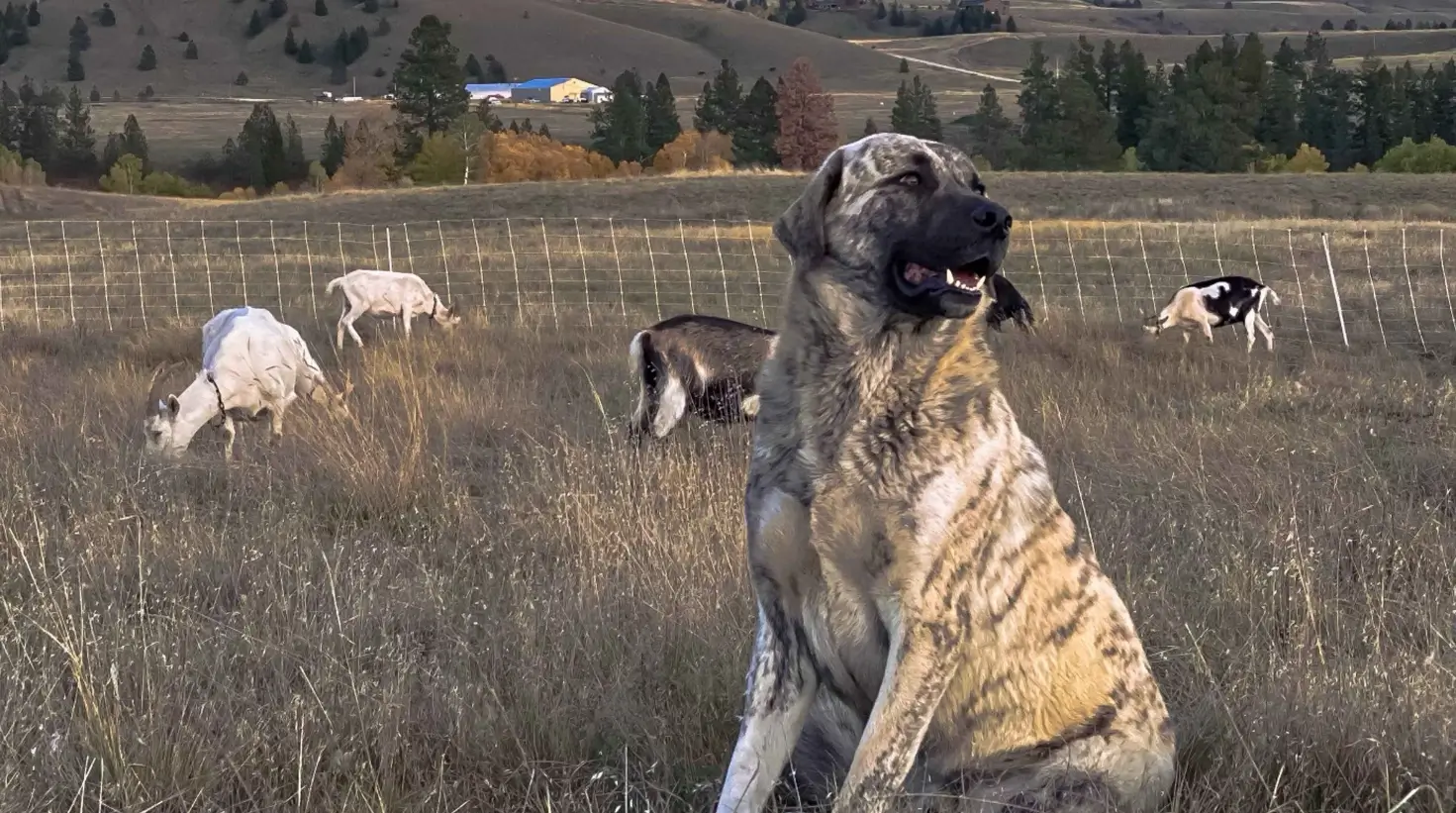The Anatolian Shepherd is a majestic and powerful breed known for its protective nature, intelligence, and impressive size. In addition to their remarkable traits, Anatolian Shepherds come in various coat colors, making each dog unique. From fawn to brindle, piebald to sable, these dogs showcase various color patterns that add to their overall charm. This comprehensive guide will dive into the genetics behind Anatolian Shepherd colors and explore the different coat variations. Read on!
The Genetics Behind Anatolian Shepherd Colors
Anatolian Shepherds come in a variety of colors, including fawn, cream, gray, red, white, brindle, and piebald. The genetics involved are not completely understood, but several genes play a role.
Agouti Gene (A Locus)
The agouti gene helps determine whether a dog will be solid colored (recessive black), have banded hairs (agouti/fawn, wolf gray), or be saddle marked (black with lighter points). Variants in this gene can produce different hues.
The A locus has several alleles, each contributing to the variety of coat colors observed in this breed:
- Ay (Sable): The Ay allele allows for the expression of both black and yellow pigments, resulting in a sable coat. Anatolian Shepherds with Ay may have a mix of black-tipped and yellow-tipped hairs, creating a varied appearance.
- aw (Agouti White): The aw allele contributes to a white or cream-colored coat with minimal agouti banding. This allele is associated with a lighter overall appearance.
- at (Tan Points): The at allele causes the dog to have tan points on specific areas, such as the eyebrows, cheeks, chest, legs, and vent region. The rest of the coat may be a different color.
- a (Recessive Black): The recessive a allele results in a solid black coat. Anatolian Shepherds with aa genotype may have a uniform black appearance.
B Locus
The B locus, or Brown locus, in Anatolian Shepherds influences the expression of eumelanin (black pigment) in their coat. The main alleles associated with the B locus are:
- B (Black): The dominant B allele allows for the full expression of black pigment. Anatolian Shepherds with the BB or Bb genotype will have a black or mostly black coat.
- b (Liver): The recessive b allele results in a liver or chocolate coat color. Anatolian Shepherds with the bb genotype will display a coat color diluted from black to brown.
K Locus
The K locus, or “Dominant Black” locus, in Anatolian Shepherds plays a role in determining the expression of black pigment in their coat. The known alleles at the K locus are as follows:
- KB (Dominant Black): This allele results in a solid black coat color. Anatolian Shepherds with the KB genotype will have a dominant black appearance.
- KBr (Brindle): The KBr allele produces a brindle pattern, characterized by dark stripes on a lighter background. Anatolian Shepherds with the KBr genotype will display a brindle coat pattern.
- Ky (Non-dominant Black): The Ky allele allows other loci, such as A and E loci, to dictate the color of the dog. It does not express dominant black, leading to a coat color determined by other genetic factors.
E Locus
The E locus, or Extension locus, in Anatolian Shepherds influences the expression of eumelanin (black pigment) in their coat. There are several alleles associated with the E locus:
- Em (Melanistic Mask): This allele is associated with a black mask, affecting the face and ears. Anatolian Shepherds with the Em allele may exhibit a darker coloration in these areas.
- E (Full Color): Dogs with the E allele fully express eumelanin. This allele allows for the full range of black pigment in the coat without restriction.
- e (Recessive Red): The recessive red allele results in a red or yellow coat color by restricting the expression of eumelanin. It allows only phaeomelanin (red/yellow pigment) to be expressed.
Other genes that may impact Anatolian Shepherd color include the D locus (dilution causing blue/isabella) and intensity locus (paling of red to cream/white). Many colors likely result from combinations of variants at these pigment genes. For example, a fawn Anatolian may be agouti with an e/e genotype, while a brindle may have E/e plus the brindle mutation.

Anatolian Shepherd Colors Chart
Here is a chart of the standard colors for Anatolian Shepherds:
| Color | Description |
|---|---|
| Fawn | Light tan to deep reddish-brown |
| White | Pure white or cream |
| Brindle | Dark stripes on a fawn base |
| White and biscuit | White with light tan patches |
| Liver | Dark brown |
| Red fawn | Reddish-brown |
| Blue fawn | Grayish-brown |
| Gray fawn | Grayish-tan |
| Pinto (Piebald) | White with any other color |
Anatolian Shepherd Colors
The Anatolian Shepherd dog breed displays a variety of coat colors. Some of the most common colors and color patterns include:
- Fawn – Ranges from a light cream to a deep reddish fawn. This seems to be the most common coat color in the breed.
- White – Anatolian Shepherds can have all-white coats or white spots and markings in piebald patterns.
- Gray – Wolf gray and lighter silver-gray coats are seen. Gray patterning can include agouti banding of the hairs.
- Cream – Pale cream or biscuit coat color without significant red tones.
- Red – Deep red coloring, though not as common as lighter fawn shades.
- Brindle – Stripes of black or gray mixed with red/fawn on the coat.
- Black – Solid black or saddle-marked black with tan/lighter points does occur but is rarer.
Variations in Markings
Beyond the primary coat colors, Anatolian Shepherds may display variations in markings. Some may have a black mask that extends over the eyes and ears, while others may showcase white markings on the chest and paws. These subtle variations contribute to the breed’s overall charm and diversity.
Recognizing a Healthy Coat
Regardless of the specific color, a healthy Anatolian Shepherd’s coat should exhibit a glossy sheen and feel dense to the touch. Regular grooming, including brushing and occasional baths, helps maintain the coat’s health and enhances the natural radiance of the chosen color.
Accepted Anatolian Shepherd Colors by Kennel Clubs
All coat colors found in the Anatolian Shepherd dog are officially recognized and acceptable according to prevailing breed standards. Coat color is not a selection criterion in this breed. These variations are recognized to play a vital role in breed registration and standardization, albeit with differing criteria across kennel clubs.
Conclusion
In conclusion, the colors of Anatolian Shepherds vary due to genetic factors. Understanding the genetics behind these colors can help you better understand your dog’s coat. You should note that coat color does not directly impact an Anatolian Shepherd’s health.
ALSO READ: Boz Shepherd: Everything You Should Know
Frequently Asked Questions
Does color affect an Anatolian Shepherd’s price?
The color of an Anatolian Shepherd usually does not impact its price. The breed standard recognizes various colors and patterns, including fawn, brindle, and white. Factors such as breeder reputation, pedigree, and health testing are more influential in determining the price. Choose a reputable breeder who prioritizes health and temperament when selecting a puppy.
Are some Anatolian Shepherd colors more popular than others?
The popularity of Anatolian Shepherd colors can vary based on personal preference and breeding practices. Common colors include fawn, brindle, white, and cream. Rare colors like black or blue may be sought after by some owners. Ultimately, color should not affect health or temperament.
What is the rarest color for this breed?
Solid black or black-pointed (like a Dobermann) Anatolian Shepherds are rather uncommon. They do occur but less frequently compared to other colors.
Does coat color indicate anything about ancestry?
Not necessarily. Their color diversity reflects the landrace history over centuries in Turkey. All colors have old, established genetic lineages.
Does coat color affect working ability?
No. Anatolian Shepherds are still utilized as working livestock guardian dogs where color does not influence aptitude or performance.
Do certain Anatolian Shepherd colors have specific health problems?
No, there are no color-linked health issues documented. Good breeders focus on overall soundness and genetic diversity for robustness.
Do the pups change color with age?
Pups may lighten or darken somewhat as the adult coat comes in over their first year. Most retain aspects of their puppy shading.
